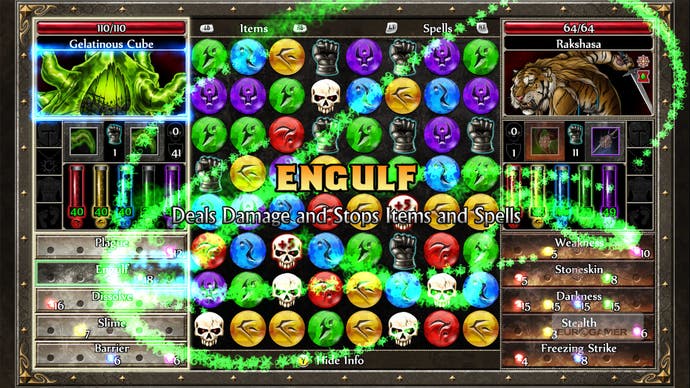Puzzle Quest 2
So you're back, from outer space.
Forget being the best: Puzzle Quest is a testament to the fearsome power of clever mediocrity. With the first game in the series, Infinite Interactive took a not-always-convincing coating of RPG ideas, slapped it onto a so-so match-three chassis, and the result still managed to captivate and ultimately consume most of its players. You enjoy Puzzle Quest, perhaps, with the part of your brain that decided that you should really paint the inside of your house magnolia. In fact, playing Puzzle Quest is probably as close as you can get to painting your brain magnolia, too.
So, what's new with the sequel? After Puzzle Quest: Galactrix and its heretical hexes took the franchise on a doomed foray into space, the developer is clearly playing it safe with the first true follow-up.
There are tweaks here and there, but the same back-and-forth structure (I wanted to call it "antiphonal", but the part of my brain that ensures I don't wear turtleneck sweaters outside of the house held me back, thankfully - and I'm also not entirely sure it's the right word) returns: you traipse around a meagrely-imagined fantasy land and then duke it out with monsters in fast-paced gem-offs. If you've worked your way into the simple rhythm of Puzzle Quest and don't wish to shake it, this isn't a game that's going to upset you too much.
It has shifted its focus somewhat, however, pulling the camera in from the lofty heights of an overworld map and turning the game into a close-up dungeon crawl instead. In Puzzle Quest 2, you wander through each mysterious crypt a single room at a time, and explore individual lanes and alleyways of every encampment you come across.

Character models are larger, those sidelining interruptions seem considerably less regular - the first game couldn't wait to mire you in citadel management and mounts - and the story has come to the forefront a little bit, even if it is still the same delightful old nonsense about goblins and curses. These are predominantly aesthetic changes, certainly, but they make the game flow a little easier all the same.
If the questing business has been simplified, there's a bit more variety on the gem-swapping agenda, with mini-games - a lift, I think, from Galactrix - interrupting the beast-pummelling and boss battles every 20 minutes or so. They still play out as match-three standards, but often offer specific twists, giving you a set number of moves to break down a door or loot a treasure chest, say, or forcing you to tackle elemental hazards by clearing the board of certain colours.
On the main battle board itself, the game has had minimal, but welcome, interference. Coloured gems still build up your mana, allowing you to cast a range of class-specific spells, and skulls still deal direct damage against your enemies, but matching new gauntlet gems now lets you charge equipped weapons for heavier attacks.


